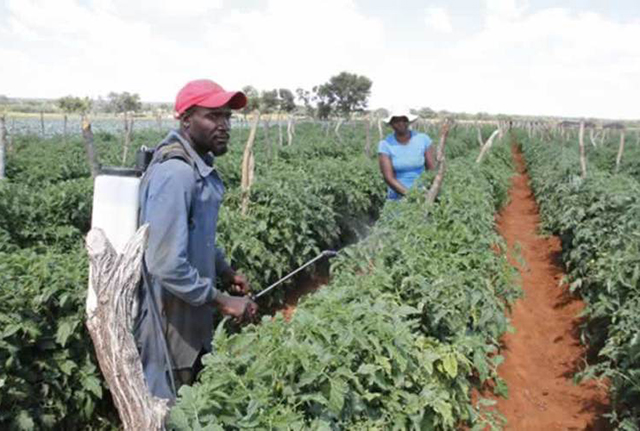Managing health risks posed by pesticides

 Andrea Rother Review Correspondent
Andrea Rother Review Correspondent
People outside the scientific community, particularly in low-and middle-income countries, often raise these questions.
Understanding the difference between hazards and risks of pesticides, how they are regulated, and how these hazards and risks are communicated, is key to answering them.
In Africa pesticide hazards are not communicated in a way that promotes risk prevention. Many people still assume pesticides are “safe”.
State of play
Regulators and researchers are concerned about more than just the toxicity of pesticides.
They are also concerned about the damage that pesticides can cause to people’s health, including causing cancer, allergies and infertility or even leading to death.
But measuring this is difficult because the context of where a pesticide is used, how much is used, how often and by whom is far less controllable outside a laboratory than inside one.
The known acute and chronic effects of pesticides are set out in the World Health Organisation’s acute hazard classifications and the Globally Harmonised System of Classification and Labelling of Chemicals.
But there are a number of challenges linked to risk assessments. These include that:
they are expensive, time consuming and context dependent;
many are conducted by transnational pesticide companies that are trying to register a pesticide in a particular country. This raises questions around the efficacy of the assessments;
data extrapolated for human risk modelling is often based on a healthy European male weighing at least 85kg. Most people living in low-and middle-income countries like South Africa do not have this profile; and
human testing is unethical and not an option.
Pesticides do not discriminate
Pesticides are inherently toxic; they kill, repel or control the pest.
But they are not indiscriminate. They do not know which species is the target species.
Pesticides are extensively used in low-and middle-income countries, often under the assumption that the highest risk of exposures occurs in the agricultural sector and predominately for agricultural workers.
But everyone is exposed to multiple pesticides in a variety of contexts, including homes, gardens, parks, road verges, supermarkets, office buildings, hotels, restaurants, hospitals, inside commercial airplanes, timber, the bottom of boats, pets, shampoo for lice, and food.
Pesticides are often used in Africa without the required personal protective equipment.
There are several factors that lead to poor compliance.
For example, workers are given inadequate protective gear such as dust masks.
These provide very little protection and may increase exposures.
Also, workers are expected to apply pesticides in the heat of the day, which increases inhalation of fast-evaporating pesticides or heat stress compounded by protective equipment.
Also, some consumers use endocrine-disrupting pesticides to control lice in their children’s hair, despite lindane being banned for agricultural uses.
This chemical is known to increase the risk of reproductive impacts and has neurotoxic effects.
People don’t have adequate protection when using pesticides.
A further complexity with the high pesticide use in Africa is the lack of diagnosis of pesticide poisonings or exposure effects.
There are hundreds of different pesticides and, in South Africa, the training on pesticide health effects is limited, despite pesticide poisoning being a medical notifiable condition.
Medical students receive little training on symptom diagnosis linked to the different pesticides and generally only know about organophosphate poisonings.
This results in misdiagnosis or under-diagnosis .
Labels as communicators
The main vehicle for communicating pesticide health and environmental hazards and risks to the end-user is the label.
In most African countries, labels contain pictograms for advice, precautions and protective equipment required, as well as hazard toxicity colour codes based on the World Health Organisation classification.
But less than 50 percent of trained South African farmer workers could correctly define and apply the meaning of the label pictograms and colour codes.
The general public, health professionals and exposed workers generally are unable to:
identify the four toxicity colour codes; and
use them in a manner that reduces exposure risks.
Research shows that communicating pesticides risks requires different mechanisms depending on the target audience.
So is the label a viable tool? Do people read a pesticide label before use, particularly for health effects? Can they understand the implications on the label?
Research suggests the answers to these questions is “no”.
In effect, the pesticide label — a legally binding document in South Africa — protects the industry from liability rather than the end-user from potential health risks.
Coming to grips with what “safe” means
The United Nations is encouraging and supporting countries to identify highly hazardous pesticides based on eight criteria.
This is based on the recognition that in low-and middle-income countries, the use of pesticides poses too high a risk for workers and the general population.
But even these eight criteria are not a panacea.
This is because the very definition of “safe” is problematic.
If defining safe means no risk at all, then pesticides are not — they are all intrinsically hazardous.
There is immense complexity behind the concept of assuming there are “safe” pesticides.
Hazard assessments of pesticides are on a single active ingredient and sometimes the formulated product.
In reality, we all have multiple exposures to pesticides, sometimes without our knowledge. But conducting research is difficult.
And there is the issue of who has conducted the research — industry or non-industry linked scientists — and when the research was conducted. — The Conversation Africa.
Andrea Rother is head of the Environmental Health Division and Associate Professor in the School of Public Health and Family Medicine, University of Cape Town.









Comments